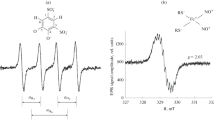Abstract
The mitochondrial electron transport chain is capable of reducing oxygen directly to water. However, 5 % of the oxygen consumption of tissues proceed by a univalent pathway in which superoxide anion, hydrogen peroxide and hydroxyl radicals are produced (for review, Thompson & Hess, 1986). Although hydroxyl radicals are very reactive, and therefore harmful, the cell is equipped with enzymes to metabolize superoxide anion and hydrogen peroxide to water, thereby bypassing the formation of hydroxyl radicals. These are superoxide dismutase, catalase and glutathione peroxidase, serving as part of physiological defense mechanisms (Thompson & Hess, 1986). Therefore, these intermediates of oxygen reduction play a pathogenic role only when their production is increased and/or when the cellular defense is reduced. Evidence has accumulated implicating oxy radical generation as an important factor in tissue injury caused by ischemia-reperfusion (Bolli, 1988; Burton, 1988; Kako et al., 1988, for reviews). Although the exact source of free radicals has not been settled, recent studies with spin resonance spectroscopy suggested it to be the endothelial cell (Zweier et al., 1988).
address for correspondence
Access this chapter
Tax calculation will be finalised at checkout
Purchases are for personal use only
Preview
Unable to display preview. Download preview PDF.
Similar content being viewed by others
References
Bolli, R., 1988, Oxygen-derived free radicals and postischemic myocardial dysfunction (“stunned myocardium”). J.Am.Coll.Cardiol. 12: 239
Burton, K.P., 1988, Evidence of direct toxic effects of free radicals on the myocardium. Free Radicals Med.Biol. 4:14.
Imlay, J.A., and Linn, S., 1988, DNA damage and oxygen radical toxicity. Science 240:1302.
Kako K.J., Kato, M., Matsuoka, T., and Mustapha, A., 1988, The depression of membrane-bound Na+ K+ ATPase activity induced by free radicals and by ischemia of the kidney. Am.J.Physiol. 254:C330.
Kaminishi, T., Matsuoka, T., Yanagishita, T., and Kako, K.J., 1989, Increase versus decrease of calcium uptake by isolated heart cells by H2O2 versus HOCl. Am.J.Physiol. (in press)
Kato, M., and Kako, K.J., 1988, Na+/Ca+ exchange of isolated sarcolemmal membrane: Effects of free radicals, insulin and insulin deficiency. Mol.Cell.Biochem. 83:15.
Shinar, E., Navok, T., and Chevion, M., 1983, The analogous mechanisms of enzymatic inactivation induced by ascorbate and superoxide in the presence of copper. J.Biol.Chem. 258: 1478. Skou,J.C, and Norby,J.G., eds., 1979, “Na, K, ATPase. Structure and Kinetics,” Academic Press,New Yo
Slaughter, R.S., Sutko, J.L., and Reeves, T.R., 1983, Equilibrium calcium-calcium exchange in cardiac sarcolemmal vesicles. J.Biol.Chem. 258:3183.
Spector, A., Yan, G., Huang, R.C., McDermott, M.J., Gascoyne,.P.R.C., and Pigiet, V., 1988, The effect of H2O2 upon thioredoxin-enriched lens epithelial cells. J.Biol.Chem. 263:4984.
ai]Thompson, J. A., and Hess M.L., 1986, The oxygen free radical system: A fundamental mechanism in the production of myocardial necrosis. Progr.Cardiovasc.Dis. 6:449.
Weiss, S.J., and Lobuglio, A.F., 1982, Phagocyte-generated oxygen metabolites and cellular injury. Lab.Invest. 47:5.
Werns, S.W., and Lucchesi, B.R., 1988, Leukocytes, oxygen radicals and myocardial injury due to ischemia and reperfusion. Free Radicals Biol.Med. 4:31.
Zweier, J. L., Kuppsamy, P., and Lutty, G. A., 1988, Measurement of endothelial cell free radical generation: Evidence for a central mechanism of free radical injury in postischemic tissues. Proc.Natl.Acad.Sci.USA. 85:4046.
Author information
Authors and Affiliations
Editor information
Editors and Affiliations
Rights and permissions
Copyright information
© 1989 Plenum Press, New York
About this chapter
Cite this chapter
Matsuoka, T., Yanagishita, T., Kako, K.J. (1989). Effects of Leukocyte-Derived Oxidants on Sarcolemmal NA,K,ATP-ASE and Calcium Transport. In: Rakusan, K., Biro, G.P., Goldstick, T.K., Turek, Z. (eds) Oxygen Transport to Tissue XI. Advances in Experimental Medicine and Biology, vol 248. Springer, Boston, MA. https://doi.org/10.1007/978-1-4684-5643-1_69
Download citation
DOI: https://doi.org/10.1007/978-1-4684-5643-1_69
Publisher Name: Springer, Boston, MA
Print ISBN: 978-1-4684-5645-5
Online ISBN: 978-1-4684-5643-1
eBook Packages: Springer Book Archive




